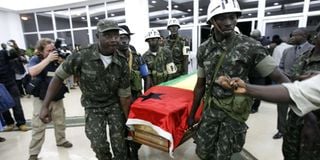Guinea-Bissau to move remains of murdered ex-president to new grave

Soldiers carrying the coffin of Guinea-Bissau former President Joao Bernardo "Nino" Vieira March 9, 2009.
The remains of Guinea Bissau’s former President João Bernardo “Nino” Vieira will Monday be relocated from Bissau municipal cemetery to José D’Amura fortress, a heroes’ corner, after the country’s cabinet approved the symbolic move.
The relocation means that President Vieira will now be officially categorised as a dignified statesman and a national hero.
The fortress harbours tombs for the country’s first President Amílcar Lopes Cabral who was buried alongside other national heroes and Bissau-Guinean influential personalities such as former Prime Minister Francisco Mendes who died in a car crash in 1978, pre-independence hero Osvaldo Vieira in whose honour the country’s main international airport is named, independence heroine Titina Silá, and Pansau Na Isna, another independence war veteran in Guinea Bissau.
Nino Vieira, who was 70 at his death, was a liberation fighter murdered in his house on March 2, 2009. His killing was thought to have been a revenge attack, after the army chief of staff died in an explosion a few hours earlier.
He was the country’s longest serving president, initially from 1980 to 1999, and later from 2005 to 2009. His charisma was tinged with controversy.
His death probe was shelved in 2017 by the country’s government.
José D’Amura fortress was built in the heart of Bissau by the Portuguese colonialists in 1696 to protect the country from French invasion.
Guinea-Bissau is one of the world's poorest states. It has a history of coups and has become a major transit route for smuggling cocaine to Europe.
Guinea-Bissau has been plagued by coups and political unrest since it gained independence from Portugal in 1974.





